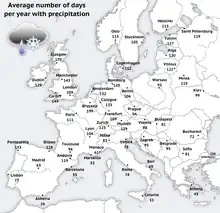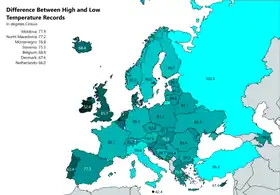Climate of Europe
Europe is generally characterized by a temperate climate. Most of Western Europe has an Oceanic climate, in the Köppen climate classification, featuring cool to warm summers and cool winters with frequent overcast skies. Southern Europe has a distinctively Mediterranean climate, which features warm to hot, dry summers and cool to mild winters and frequent sunny skies. Central-eastern Europe is classified as having a humid continental climate, which features warm to hot summers and cold winters.

The coastal lowlands of the Mediterranean Basin have more of a wet winter and dry summer season pattern, the winter season extends from October to February while the summer season is mainly noticeable in the dry months where precipitation can, in some years, become extremely scarce. A very small area in the continent features the desert climate, which exists in the south-eastern coasts of Spain making them the only places in Europe that have an arid climate.[2]
Gulf Stream



The climate of western Europe is strongly conditioned by the Gulf Stream, which keeps mild air (for the latitude) over Northwestern Europe in the winter months, especially in Ireland, the United Kingdom and coastal Norway. In terms of monthly sunshine averages, much of temperate Europe sees considerably less than the northern United States and eastern Asia.
The climate of Western Europe is milder in comparison to other areas of the same latitude around the globe due to the influence of the Gulf Stream. Western Europe is at the same latitude as parts of Canada and Russia, thus solar insulation is weak much of the year. Mediterranean waters are not as deep as the large oceans, allowing it to become a heat storage tempering winters along its coastlines, but because the Atlantic Ocean is largely influenced by the gulf stream, this effect is reduced when compared to that of the Atlantic waters.[3] The Gulf Stream is nicknamed "Europe's central heating", because it makes Europe's climate warmer and wetter than it would otherwise be.
Compared to areas located in the higher middle latitudes, parts of western Europe have mild winters and higher annual temperatures (though summers are cooler than locations at the same latitude). Berlin, Germany; Calgary, Canada; and Irkutsk, in the Asian part of Russia, lie on around the same latitude; January temperatures in Berlin average around 8 °C (15 °F) higher than those in Calgary (although Calgary sits 1200m higher in altitude), and they are almost 22 °C (40 °F) higher than average temperatures in Irkutsk.[3]
This difference is even larger on the northern part of the continent. The January average in Brønnøysund, Norway,[4] is almost 15 °C warmer than the January average in Nome, Alaska,[5] both towns are situated upwind on the west coast of the continents at 65°N, and as much as 42 °C warmer than the January average in Yakutsk which is actually slightly further south. Further south the oceanic climate of Europe compares thermally to North America, at around 48°N Rennes, France has about an equal average temperature throughout the year to Seattle, Washington, although the latter has drier summers with much wetter winters.[6]
Within mainland Spain, the arid climate appears predominantly in Almería.[7] The desert climate extends to the Andarax and Almanzora river valleys, Alicante and the Cabo de Gata-Níjar Natural Park, which are also known for having also a hot desert climate (Köppen: BWh), with a precipitation amount of 156 mm (6.1 in) per year[8] which is reportedly the driest place in Europe.
Temperature

Most of Europe sees seasonal temperatures consistent with temperate climates in other parts of the world, though summers north of the Mediterranean Sea are cooler than most temperate climates experience in summer (for example summers in the temperate sector of the northern United States are much hotter in summer than Europe). Among the cities with a population over 100,000 people in Europe, the coldest winters are mostly found in Russia, with daily highs in winter averaging 0 °C (32 °F), while the mildest winters in the continent are in southern Portugal, southern Spain, in Sicily (Italy) and southern Greek islands such as Crete, Rhodes, Karpathos and Kasos.
The hottest summers of the continent occur in cities and towns of the hinterland of southern Spain, southern Greece and southern Italy. July average highs in Spain are 36.9 °C (98.4 °F) in Cordoba and 36.0 °C (96.8 °F) in Seville. July highs in Greece average around 36.0 °C (96.8 °F) in Sparta. The highest extreme temperatures have been recorded in Syracuse, Italy, with 48.8 °C (119.8 °F),[9] Athens and Elefsina, Greece, with 48.0 °C (118.4 °F)[10] and inside the southern valleys of the Iberian Peninsula, with towns such as La Rambla, Cordoba (Spain) and Amareleja (Portugal) recording temperatures of 47.6 °C (117.7 °F) [11] and 47.4 °C (117.3 °F)[12] respectively.
Tornadoes
The Netherlands has the highest average number of recorded tornadoes per area of any country in the world (more than 20, or 0.0005 per km2), annually), followed by the UK (around 33, or 0.0001 per km2), per year),[13][14] but most are small and cause minor damage. In absolute number of events, ignoring area, the UK experiences more tornadoes than any other European country, excluding waterspouts.[15] Europe uses its own tornado scale, known as the TORRO scale, which ranges from a T0 for extremely weak tornadoes to T11 for the most powerful known tornadoes.[16]
Climate change
.png.webp)
Impacts on European countries include warmer weather and increasing frequency and intensity of extreme weather such as heat waves, bringing health risks and impacts on ecosystems. European countries are major contributors to global greenhouse gas emissions, although the European Union and governments of several countries have outlined plans to implement climate change mitigation and an energy transition in the 21st century, the European Green Deal being one of these. The European Union commissioner of climate action is Frans Timmermans since 1 December 2019.[21]
Public opinion in Europe shows concern about climate change; in the European Investment Bank's Climate Survey of 2020, 90% of Europeans believe their children will experience the effects of climate change in their daily lives.[22] Climate change activism and businesses shifting their practices has taken place in Europe.See also
References
- Beck, Hylke E.; Zimmermann, Niklaus E.; McVicar, Tim R.; Vergopolan, Noemi; Berg, Alexis; Wood, Eric F. (30 October 2018). "Present and future Köppen-Geiger climate classification maps at 1-km resolution". Scientific Data. 5: 180214. Bibcode:2018NatSD...580214B. doi:10.1038/sdata.2018.214. ISSN 2052-4463. PMC 6207062. PMID 30375988.
- "IBERIAN CLIMATE ATLAS" (PDF). www.aemet.es. Retrieved 2020-08-17.
- "European Climate". World Book. World Book, Inc. Archived from the original on 2011-07-23. Retrieved 2011-02-15.
- Brønnøysund
- Nome
- Yakutsk
- Meteorología, Agencia Estatal de. "Almería Aeropuerto: Almería Aeropuerto - Agencia Estatal de Meteorología - AEMET. Gobierno de España". www.aemet.es.
- "LOS CLIMAS SECOS DE ESPAÑA SEGUN EL SISTEMA DE KOPPEN" (PDF). digitum.um.es. 1987. Retrieved 2020-08-17.
- "WMO is monitoring potential new temperature records". public.wmo.int. 17 July 2023. Retrieved 18 July 2023.
- "WMO Region VI (Europe, Continent only): Highest Temperature". World Meteorological Organisation. Retrieved 8 November 2020.
- "14 de agosto de 2021,se batió el récord de temperatura más alta registrada en España" (in Spanish). Agencia Estatal de Meteorología. 2 August 2022. Retrieved 2 August 2022.
- Extremes Archived 21 June 2017 at the Wayback Machine Instituto Português do Mar e da Atmosfera, IPMA
- J Holden, A Wright (2003-03-13). "UK tornado climatology and the development of simple prediction tools" (PDF). Quarterly Journal of the Royal Meteorological Society. 130 (598): 1009–1021. Bibcode:2004QJRMS.130.1009H. CiteSeerX 10.1.1.147.4293. doi:10.1256/qj.03.45. S2CID 18365306. Archived from the original (PDF) on 2007-08-24. Retrieved 2009-12-13.
- Staff (2002-03-28). "Natural Disasters: Tornadoes". BBC Science and Nature. BBC. Archived from the original on 2002-10-14. Retrieved 2009-12-13.
- Nikolai Dotzek (2003-03-20). "An updated estimate of tornado occurrence in Europe" (PDF). Atmospheric Research. 67: 153–161. Bibcode:2003AtmRe..67..153D. doi:10.1016/S0169-8095(03)00049-8. Archived from the original (PDF) on 2007-06-14. Retrieved 2009-12-13.
- Meaden, Terrance (2004). "Wind Scales: Beaufort, T — Scale, and Fujita's Scale". Tornado and Storm Research Organisation. Archived from the original on 2010-04-30. Retrieved 2009-09-11.
- Kayser-Bril, Nicolas (24 September 2018). "Europe is getting warmer, and it's not looking like it's going to cool down anytime soon". EDJNet. Retrieved 25 September 2018.
- "Climate change impacts scar Europe, but increase in renewables signals hope for future". public.wmo.int. 2023-06-14. Retrieved 2023-07-09.
- "Global and European temperatures — Climate-ADAPT". climate-adapt.eea.europa.eu. Retrieved 2021-09-12.
- Carter, J.G. 2011, "Climate change adaptation in European cities", Current Opinion in Environmental Sustainability, vol. 3, no. 3, pp. 193-198
- Abnett, Kate (2020-04-21). "EU climate chief sees green strings for car scrappage schemes". Reuters. Retrieved 2020-10-06.
- "EU/China/US climate survey shows public optimism about reversing climate change". European Investment Bank. Retrieved 2021-07-15.
Further reading
- Seager, Richard (July–August 2006). "The Source of Europe's Mild Climate". American Scientist. Vol. 94, no. 4. p. 334. doi:10.1511/2006.60.334. Subhead: "The notion that the Gulf Stream is responsible for keeping Europe anomalously warm turns out to be a myth".
{{cite magazine}}: CS1 maint: postscript (link)